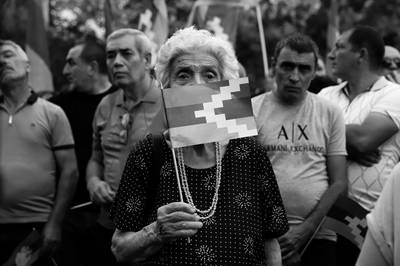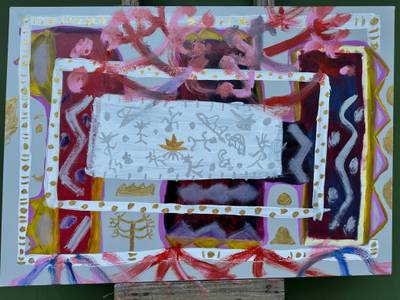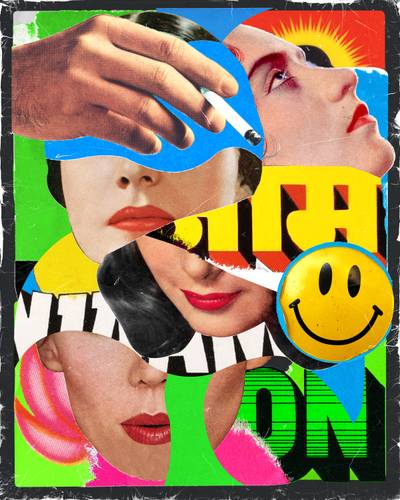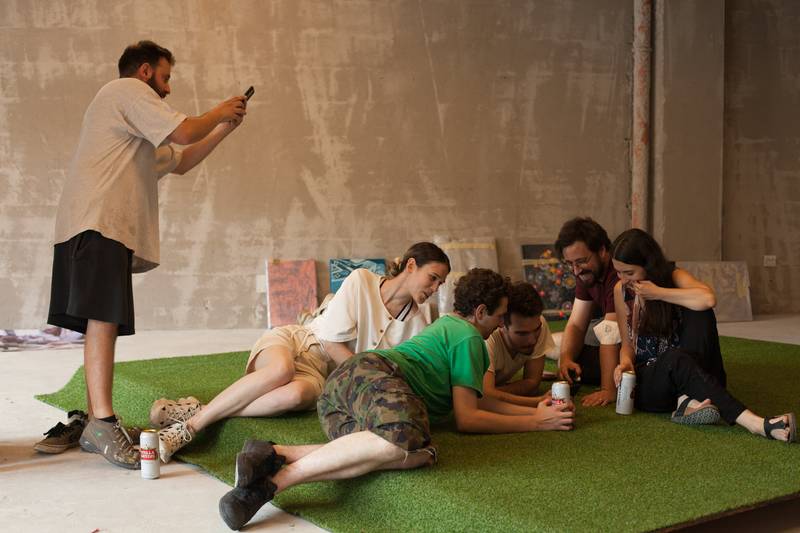

E T A J crew during a break at setting up an exhibition in Cluj
Ilina Schileru is a Romanian artist, curator, and cultural manager. She has an MA in Graphics at Bucharest University of Arts, completed in 2010. She is a member of UAP Romania and the founding director of EBienale and an art teacher for migrant children in a local NGO.
Disclaimer: this is not a how to make it in the Art world easy guide.
This is a story about a small group of young artists in Romania (zoom-in on Bucharest, please) and their endeavour of trying to make it in the Art world. We do not know how this will turn out.
The rather arid landscape of art gallery presence in a small South-Eastern country was no fertile ground to grow into a blossoming artist, in the 2010s. Two decades before that, Bucharest didn’t even have any private galleries, as the intellectual layer of society was focused on the more palpable aspects of the newly gained capitalist freedom right after the 1989 Christmas Revolution.
The highlights for everyone were the shiny new stores and a mind-blowing openness to everything western: cable tv, imported products and a general hope of development for entrepreneurship and culture. Little did we knew back then, that we were experimenting the wild-wild East, where corruption took hold, often under the guise of “investment” and brought the worst proposal a young capitalist society can start off with: down-selling the entire national production equipment and industrial sector, as scraps, in a matter of five to ten years. As a consequence of this and other examples of difficult transitions, poverty struck a large population, and political crises started rolling – and continue to this day.
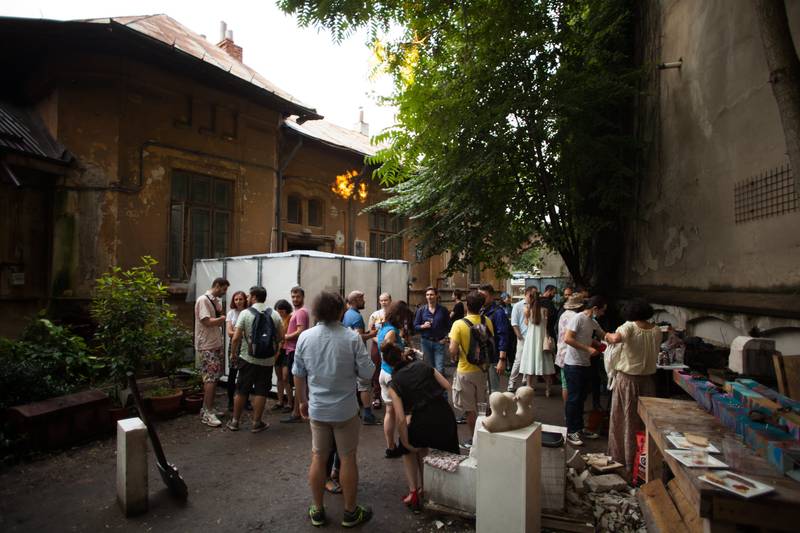

Outdoor exhibition with E T A J on wheels in Bucharest, August 2021
However, step by step, 30 years later, a new generation revealed itself, claiming its own status: Generation Z and the Millenials, the speedy-internet-connected-the shapeshifters. They are the young wolves who have a non-apologetic approach and claim space loudly and fiercely. And that is how the story of E T A J artist-run space comes to light.
The story of collective initiatives begins in the 1990s, and it is worth mentioning the ROSTOPASCA group, formed by a few artists who began with painting experiments and later attempted to transition to new media, after a revealing trip they had to New York and some time spent in the Chelsea neighborhood of Manhattan, known to the art public as the core of art galleries. Back then, ROSTOPASCA did not call themselves “an artist-run”. Starting in 1997, they ended their activity as a group in 2001, each one taking on an individual route afterwards. Former ROSTOPASCA members Nicolae Comănescu and Dumitru Gorzo are exhibiting under private galleries aegis today. The two are featured in the permanent collection of the MARe Museum, a private institution that serves as a sole surrogate to what the National Contemporary Art Museum (MNAC) has failed to cover for more than 15 years: a proper permanent exhibition to show a curated selection of the most important exhibitions and art practices occurring in the local art scene after the 1960s.
In 2021 Bucharest, there is still a scarcity of representation of young art in appropriate spaces, despite the fact that there is art with good potential. This issue created an alternative mindset. Taking a peek at how other young art societies have handled the under-budgeting and overlooking coming from the public and private institutions-those who would be the proper apparatus for promoting their art-some clusters of creatives found the artist-run experience as a proper way to start navigating the art world.
This approach serves as a power-statement, combining various voices and forces brought together independently who, at some point, can become so loud and so visible, that the establishment will be unable to ignore them. And the goal is to go all the way: infiltrating museums’ spaces and, why not, being featured at biennales and other major events. Wanting it all, conquering the high waves.
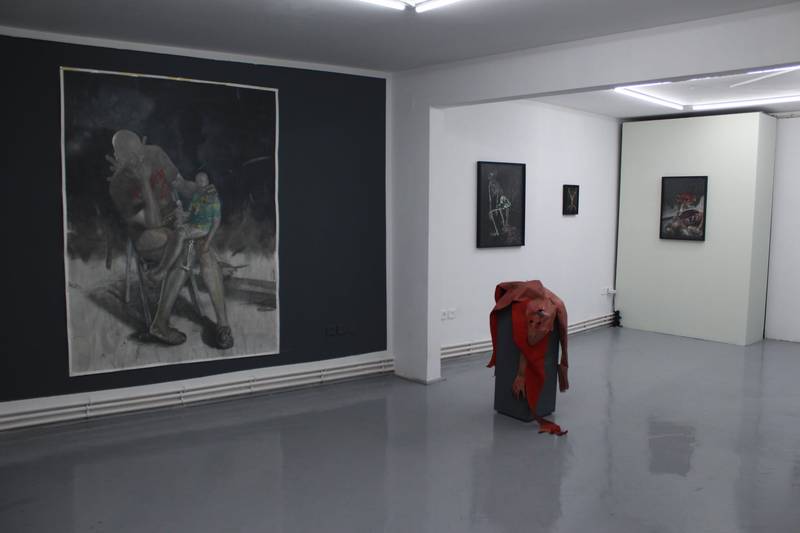

E T A J artist-run space headquarters, view from the exhibition by Adrian Ghiman, July 2021
E T A J was born in 2018, and it was founded by Mircea Modreanu and Dumitru Gurjii, both BA and MA holders of the Graphic Department(s) at Bucharest National Arts University (UNArte) and its Cluj counterpart. The group’s name “ETAJ ‘’ translates into “floor”, as the apartment space (E T A J headquarters) is on the first floor of a ’50s five-storey building downtown, next to the Roman Square, a central point for exploring the city. Right from the beginning, the two founders, Mircea and Dumitru, decided to adapt a blue-ocean strategy equivalent: creating their own narrative and dodging the bloody waters of the survival fight in order to get noticed and chosen by a local gallery. Understandably, this other road proves to be as bumpy as a rafting trip down a cold and rocky river. The trail is marked by a lot of solitude in relation to other validated entities that make up the establishment: cultural government-funded agencies, museums and long-lasting galleries and it necessitates a high degree of self-management. But it also brings much more freedom of choice in terms of themes and topics of discussion, as well as a powerful point of view that can be turned into institutional critique. This approach serves as a power-statement, combining various voices and forces brought together independently who, at some point, can become so loud and so visible, that the establishment will be unable to ignore them. And the goal is to go all the way: infiltrating museums’ spaces and, why not, being featured at biennales and other major events. Wanting it all, conquering the high waves.
He literally takes his breakfast among the art that E T A J exhibits and of course, the four-room apartment is more than often populated with artists, curators and art lovers constantly coming and going outside the opening nights: and this is how personal life permeated by the professional one.
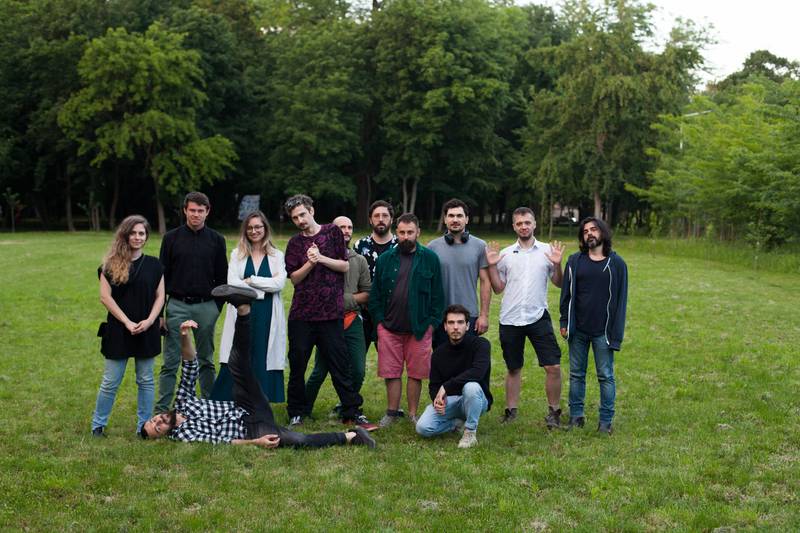

E T A J crew at Ion Ghica Palace from Ghergani after a tour-de force exhibition featuring 80 artists organized by Mircea, Dumitru and Ilina, June 2021
It may be too audacious, even outrageous, it may sound delusional, some might say, but history has seldom been made of comfort and conformity. The artworld is already in a crisis, in need of a significant change that manifests not only in the art itself but in all layers that shape today’s society as to our regard towards conserving the natural environment and more practical distribution of resources. Notably, the pandemic has only accelerated the shapeshifting, this process of nimble mentalities seeking new grounds for expression and visibility.
Coming back to our own story, E T A J celebrates four years of existence in 2021, and has collaborated with dozens of local artists since its launch, which began with a cell of only nine artists. The headquarters are located in the apartment of one of E T A J founders, Mircea Modreanu, in the heart of the city. The acquisition of his personal flat in 2018 meant the beginning of a fruitful series of public events happening every two weeks and occupying the double living room and his kitchen. Judging by the timetable of making and unmaking an exhibition, organizing two events a month means his personal home has also become a public venue for art lovers. He literally takes his breakfast among the art that E T A J exhibits and of course, the four-room apartment is more than often populated with artists, curators and art lovers constantly coming and going outside the opening nights: and this is how personal life permeated by the professional one. The expression “art is life” could hardly be more appropriate than this.
Mircea is also oftentimes the man to say the first hello once you step inside an E T A J vernissage while offering you a drink and taking a snapshot of you for the social media’s many accounts E T A J holds.
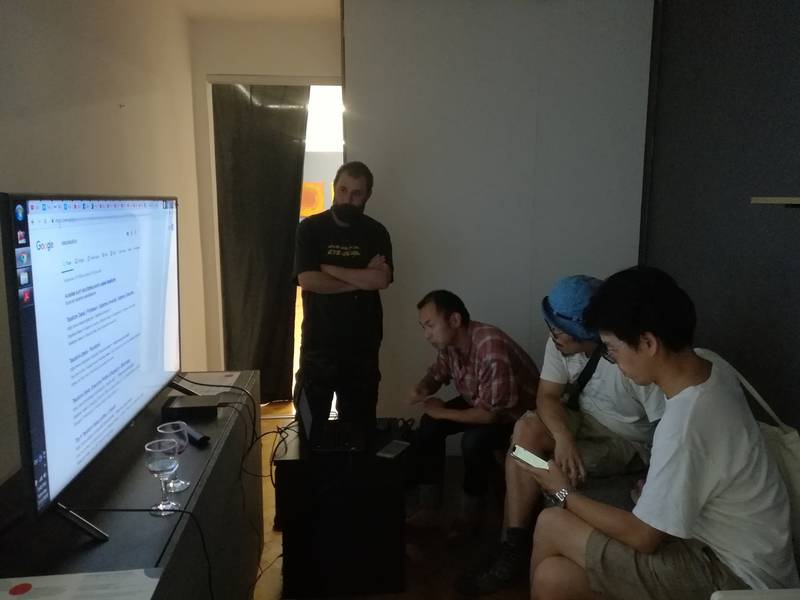

Mircea Modreanu and visitors, in his bedroom that is sometimes used as an extra-visiting space for exhibitions
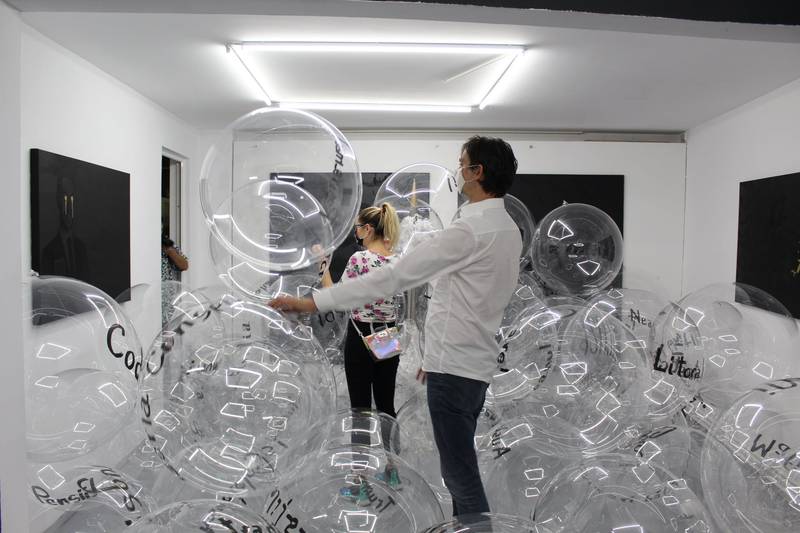

Gentle Protest by Sebastian Iacob opening at E T A J, September 2020
If you’re new to E T A J, he’ll ask you about your art practice, if you have one, and if you’re looking for an art family-like cell, this is one of the places to be in. In just four years, the hip society and some would-be art investors began to flock at the regular E T A J gatherings. It has evolved into a time and place for socializing, meeting new people, and possibly engaging with future collaborators.
As it did not settle only between the walls of the 50 square meters art-dedicated space in the apartment, the crew which grew to 7 constant active members, left the headquarters and created the mobile easily-installing E T A J gallery-cell, a PVC white cube installation that resembles an exhibition space with no roof, ready for setting up anywhere in natural or anthropic sites.
And for the recipe to be fully functional, Mircea and Dumitru bought a second-hand Ford Tranzit van from a former pharmaceutical transport company. They’ve even set up an Instagram account for the numerous trips they’ll take with it to art fairs (follow them on @dubidubaetaj). Yes, because the next level is exiting the country to meet and be met by their Nordic artist-run counterparts – as they did in August this year when they attended the first edition of Juxtapose Art Fair for artist-run initiatives. Packed like slim-sardines, they travelled 2300 km to Aarhus and back with the newly acquired van to show their selection for the non-commercial art fair.
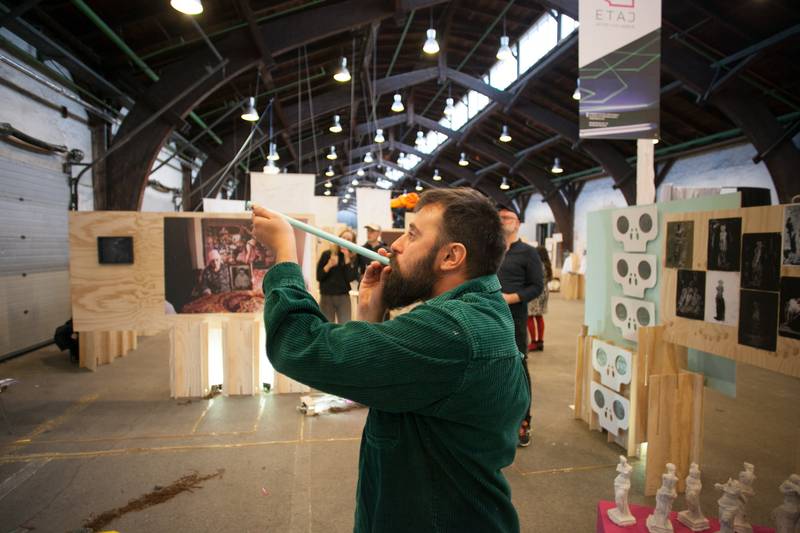

Mircea Modreanu performing during Juxtapose Art Fair in Aarhus (DK) inside E T A J artist-run space booth, August 2021
Having spent 3 days on the road, the team installed the booth the next day and began sharing short videos and Instagram stories via their social media channels. Online communication is handled by the team: one member is filming and editing, while Mircea uploads and shares with the already vast community following from back home. Attending conferences is also essential, as is visiting the other participants’ booths. That’s how they found out that they were the only south-Eastern Europeans invited to Juxtapose, the first edition fair for artist-run spaces in Aarhus, Denmark. Connections formed here are critical to community development in the arts, as well as in business. And it is also based on open conversations with other artists and curators present with their own initiatives.
This article is written from Hungary, while they are just opening the G1007 booth at the Art Market Budapest, showcasing a collective art installation bed alongside their individual works, with bedsheets that feature the entire group as your art Fetish-dream making machine. The concept of the booth could easily be Mircea’s living room in Bucharest, as he holds artwork on the walls with little room to spare, and also under his bed. The reactions of the fair’s public are delightfully engaging and an ice-breaker for initiating a conversation, as they are invited to take a break on the Fetish bed installation.
The exhibitions always come up with a story reference to the artists who resort to DIY solutions born out of frustration, as the cultural institutions are always waiting on outside validation first, to reclaim the value of one’s efforts.
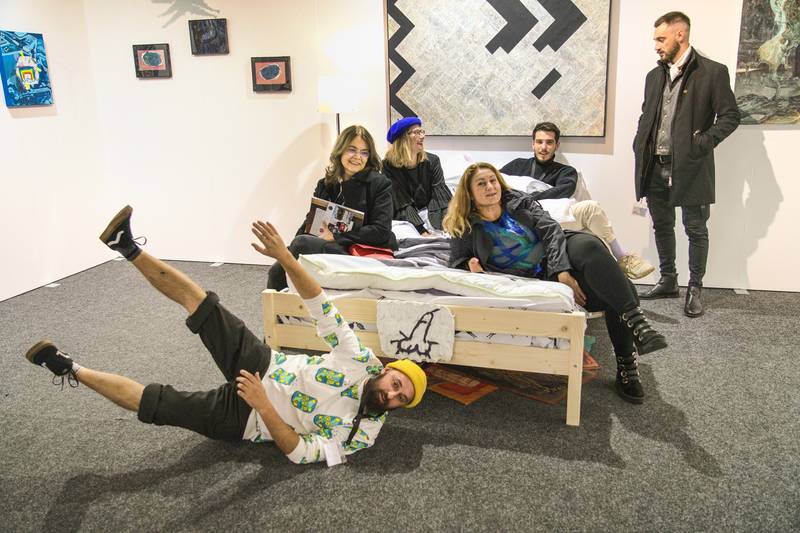

E T A J crew and the Romanian Cultural Institute team on the installation bed FETISH at Budapest Art Market, October 2021
The exhibitions always come up with a story reference to the artists who resort to DIY solutions born out of frustration, as the cultural institutions are always waiting on outside validation first, to reclaim the value of one’s efforts. Dan Perjovschi, one of the most notorious contemporary artists in Romania suggests in his Vice interview with Ioana Calen (2015)1 that this is truly a sad reality. The numerous hours spent in filling out impossible amounts of documentation to apply for public state funding are proven to be wasted chunks of time that should be invested elsewhere.
So how do you make your own story? You defy the establishment and force it to acknowledge your visibility while navigating the muddy and shark-infested art scene waters – the so-called red ocean in business strategy. So while red ocean strategy tends to focus on keeping the usual clientele (art investors that buy works by established artists, in a market sustained by the ”blue-chip” galleries who are focused only on selling and growing the art prices – the secondary market), the blue ocean strategy aims to increase the size of the industry (experimenting new fields and playing with interdisciplinarity – they make the primary markets). Sometimes spice it up with a rebellious tinge and lots of humour. The main course is community work, loyalty, helping and promoting each other, making space for the group as a collective. Each individual brings something to the table, skill-wise.
It is often a bumpy sail, as some decide to flee and abandon a ship or raft while looking for other ways to dock on blue-chip, bigger fishing nets. The ones who decide not to abandon ship are doing so believing that the efforts of all, as a group, have a much better chance at surviving and prospering.
Exiting the artist-run space and putting one’s self in uncomfortable and tough situations as designing experiences such as a boat-access-only exhibition (OFFSHORE WHITE CUBE, August 2020, near Bucharest) or taking the time to develop an on-route project by literally packing the walls of exhibition space in your van and just popping-it up in a cornfield (programmed for October 2021) or inside of another gallery (Matrioska, a group-show at Matka in Cluj-Napoca City, June-July 2021), feels often like a madman’s work and schedule. But altogether inspiring.
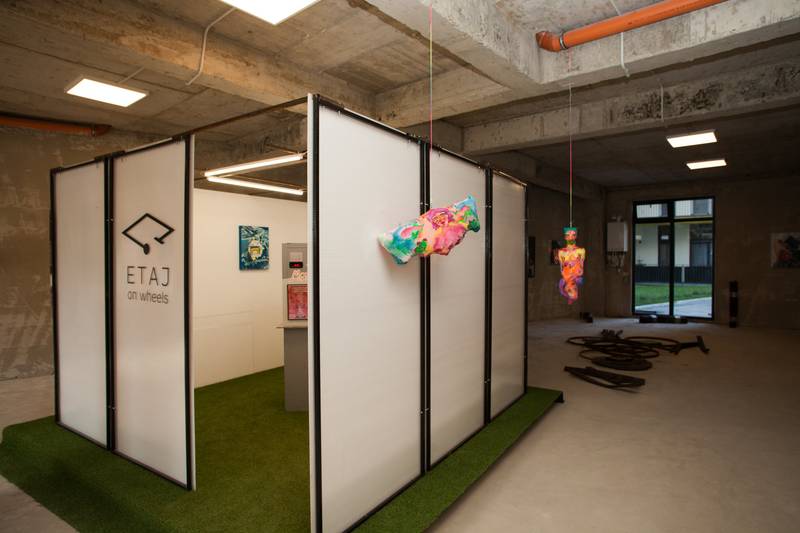

E T A J on wheels - exhibition within another gallery (Matrioshka Exhibition in Cluj), June 2021
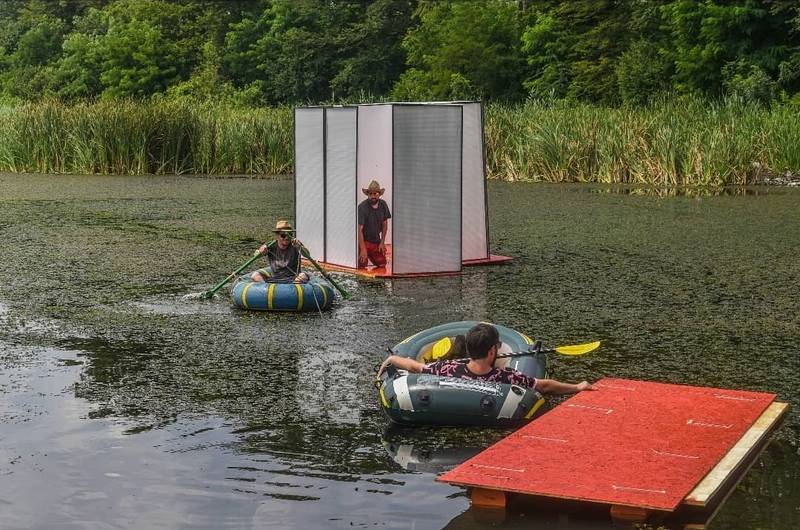

Founders of E T A J artist-run space, Mircea and Dumitru, setting up the OFFSHORE WHITE CUBE exhibition on the lake, August 2020
From the outside world, they feel like super-men and-women, with infinite resources of energy, but from the inside it feels like a constant on-the-run modus vivendi. While events add up, material that has to be curated and distributed online piles up, the rhizomes of this artistic fungus continue to grow and attract others that would like to join in on the experience.
After several years on the art scene, the emails with proposals for collaborations start to add up, and the energy then has to be spent only on a best-selection array of projects.
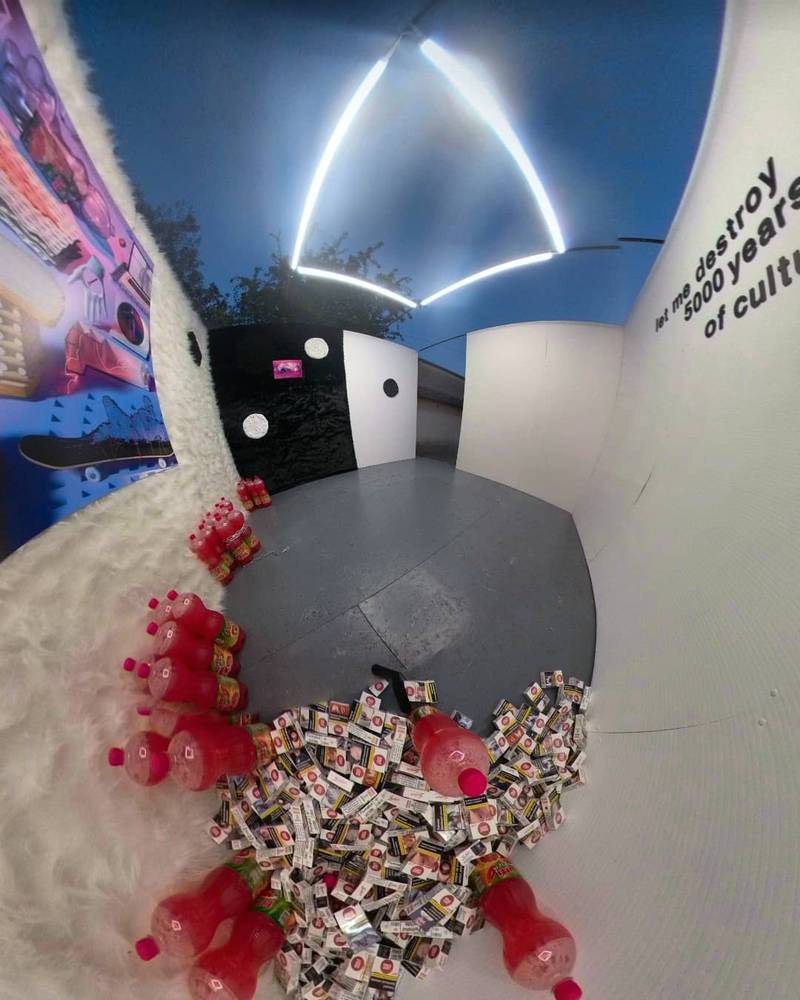

An inside view of the mobile gallery E T A J on wheels
Future games to play
Starting 2022, E T A J plans to launch its residency program for foreign artists open to collaborations and it will be focused on other artist-run initiatives. The residency will create possibilities for its participants to meet the E T A J community and the entire Bucharest local art scene. The program marks an extension of Mircea’s apartment and into another DIY space that will function as a pop-up gallery in a very strategic location where you can visit other emerging and established galleries from Bucharest, on the site of the former Union’s Artists factory.
The programme is to be doubled by another project that aims to make the mobile pop-up gallery into an itinerary ongoing show to be seen in rural spaces in Romania. Following in the footsteps of conceptual artist Alberto Greco, one of the catalyst figures in contemporary art in Argentina, the E T A J team is opening up to diverse urban and rural spaces creating performances and experiences, while expanding the circulation of art to new audiences. Just as him, E T A J aims to de-hierarchize art, by merging it with real-life situations, showing art in real-life environments to a public that has most probably never been exposed to it. Considering the access of the peripheric society to art is also a priority for E T A J, as public strategies live only on paper or are non-existent in many areas. And education is the main provider of future generations to value and prioritize culture. Also, artists often arise from such societal layers, so integrating art into these communities is non-optional.
The coming year is shaping up to be a very productive one, as the connections with the outside events and initiatives alike continue to grow (hi to The Juxtapose team, Sasha Richter and Jacob Ruhl!) and the possibilities for engaging with an array of experiences as fairs and biennials become very achievable realities.
Is this a recipe for making it into the art world? It could be, but only time will tell. The important aspect to remember in all of this is to have fun while doing it and to stay true to and open about your convictions. Is it a guarantee that you will arrive safely in the front row of the art scene? Far from it, the art world offers no guarantees and is frequently a hostile environment for newcomers to the stage. In other words, it could be similar to trading on financial markets: there is a good chance of big wins but also big losses. No matter the case, it is not for the faint-hearted.


